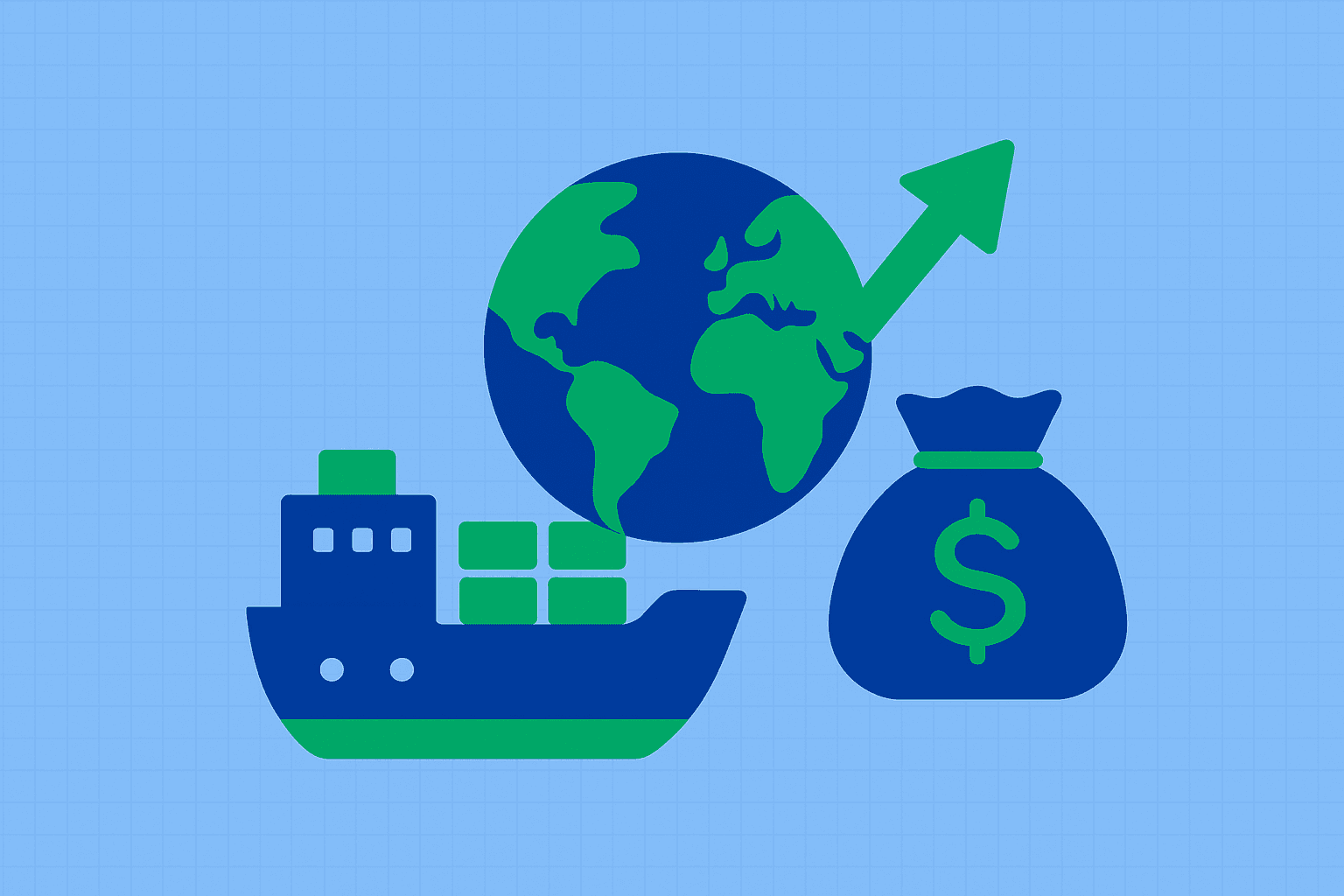7 Easy Steps to Create a Successful Project Framework


In an orchestra, the maestro plays a vital role in bringing each musician who specialises in different instruments. The maestro must coordinate the efforts of each musician, ensuring they are in sync, following the same tempo, and producing harmonious music. Just like that, a project manager requires the ability to lead and coordinate a diverse team of individuals with various expertise, ensuring that everyone is working towards a shared vision and goal.
The project manager acts as the maestro, guiding and orchestrating the team's efforts to achieve a successful project outcome. Findstack found that only 43% of projects wrap up within their initial budget, and only 29% finish on time.
That's why having a solid, reliable framework is our secret weapon. It can make all the difference between a project that flourishes and one that flounders. So, let's explore this a bit more, shall we?
#1. Define clear project objectives
Project objectives are your outcomes, deliverables, or the ultimate value you want to deliver on the completion of the project. However, many people confuse project objectives and project goals.
Objectives are tangible results measured using specific metrics. On the other hand, goals are long-term targets that consider a broader picture.
Examples:
- Project Objective: Increase website traffic by 25% by implementing search engine optimisation techniques within the next two months.
- Project Goal: Improve website visibility and attract more traffic through search engine optimisation techniques.
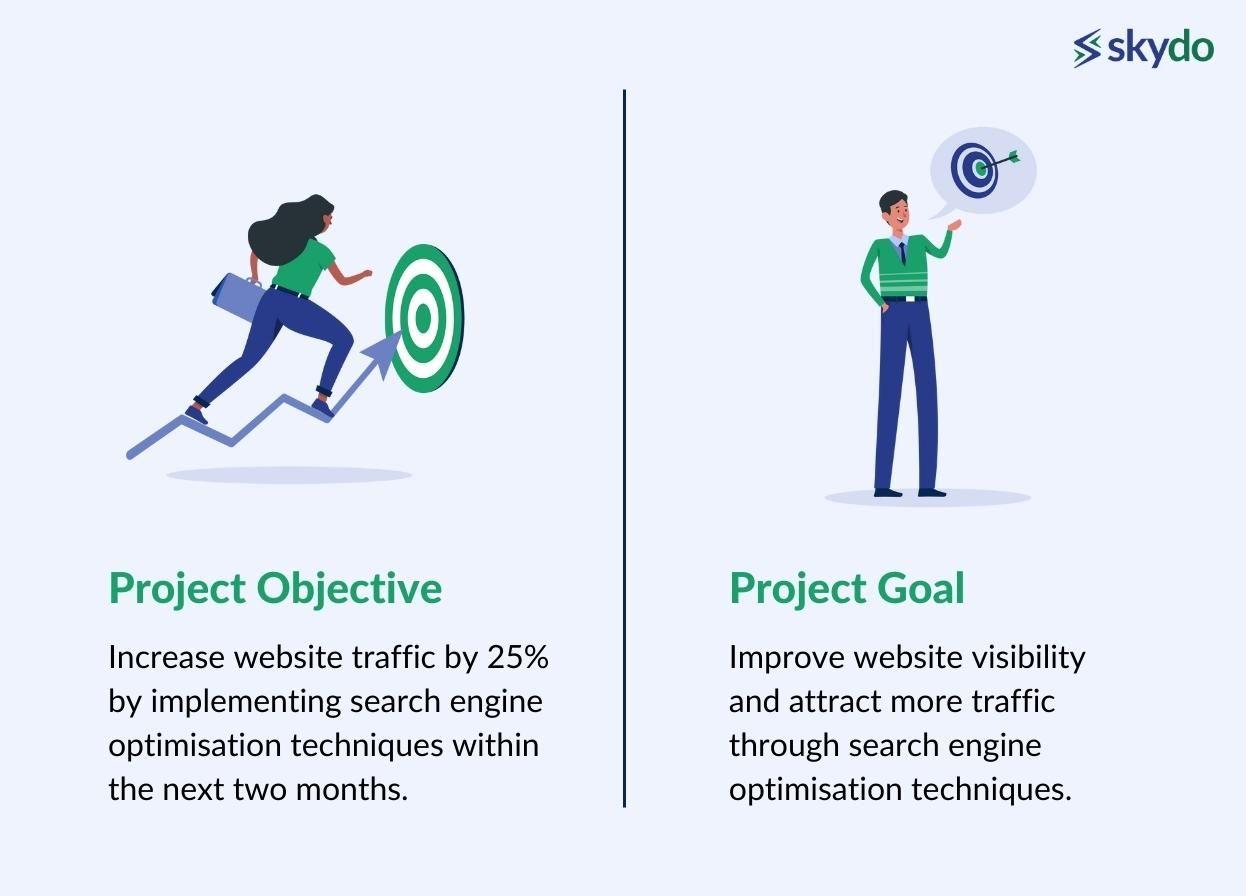
The key to understanding the difference lies in defining SMART objectives.
- Specific: Write a specific goal. Start with figuring out who, what, when, where, and why.
- Measurable: Incorporate specific metrics that answer "how much" or "how many."
- Achievable: Define a realistic objective, one that you can truly achieve based on the skills or resources available.
- Relevant: The objective should align with overall organisational goals.
- Time-bound: Assign a reasonable and fixed deadline.
Here is a template you can use to write SMART project objectives:
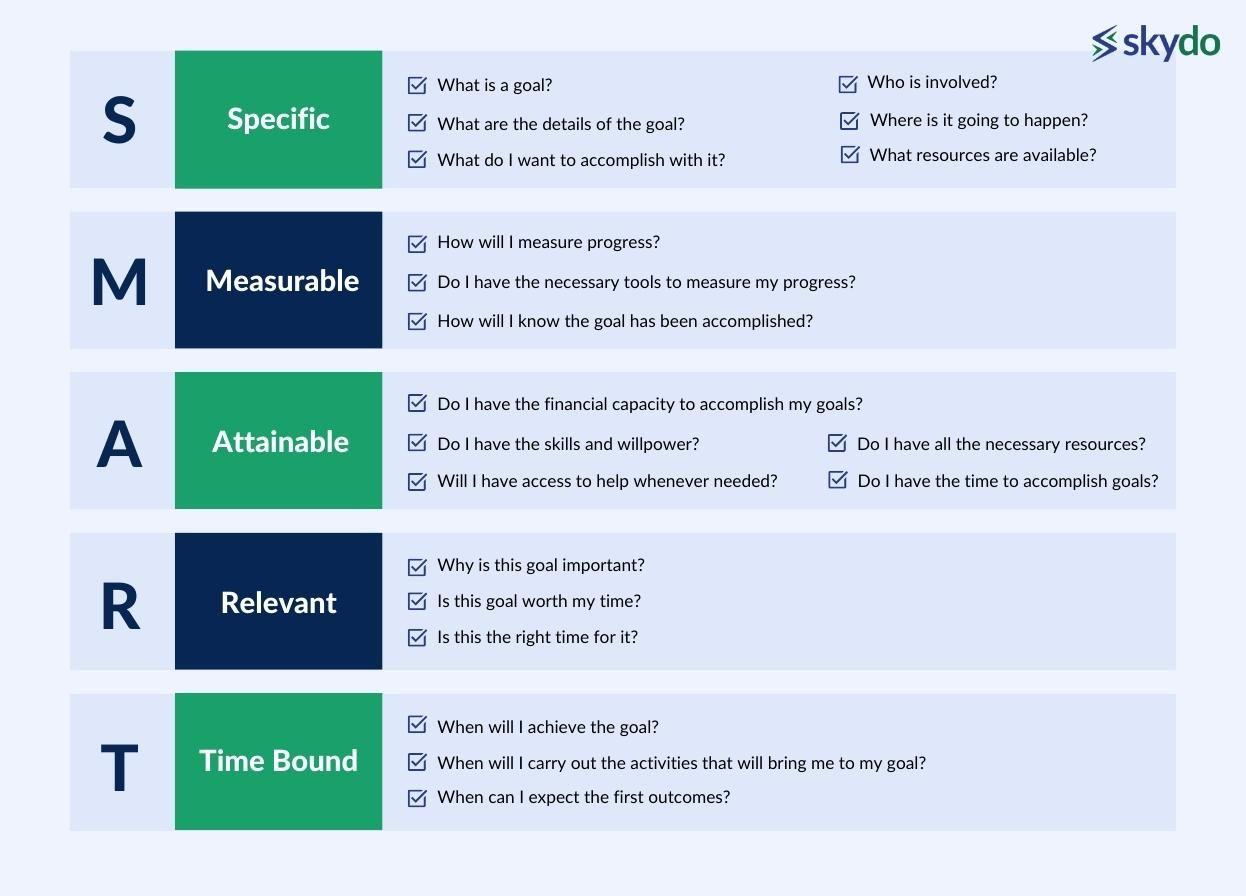 Source: Clockify
Source: Clockify#2. Assemble a skilled and dedicated team
Project management is also a lot about people management. The key factors that you must consider while building a team include:
- Does the candidate possess the right skills to complete the project within the timeline?
- What are an individual's personal and professional goals, and whether those align with the project objectives and goals?
- Does the candidate have interpersonal skills and the right attitude?
- Are you focusing on team diversity by hiring people with varied skill sets?
The next step is team development. There are four main stages in the team development process:
- Forming: Provide guidance and direction to the team members to establish a clear path forward.
- Storming: Offer emotional and practical support to overcome frustrations and motivate team members to reach project milestones.
- Norming: Foster trust and a strong team spirit as members begin trusting each other and the leader.
- Performing: Delegate tasks as the team progresses, capitalising on their strengthened abilities and significant progress towards project completion.
Tips that can help you in achieving team building and development effectively include–
- Frequent and clear communication
- Encourage members to participate in goal-setting and decision-making process
- Motivate them to achieve their individual goals
- Promote healthy competition within the team
#3. Develop a detailed project plan
The best way to create a detail-oriented project plan is to find answers to what, who, when and how and add other elements. For example:
What needs to be done?
- First, define a problem statement and a project mission statement
- Next, define SMART project objectives as described above
- Add deliverables for project milestones for various stages
How does it need to be done, or what resources will be required for the project?
- Create a list of all project requirements like hardware, software, data, etc.
- Define exit criteria if the deliverables of the previous milestone are not achieved.
Who will do it?
- Allocate tasks based on the competencies of team members.
By when will the task be completed?
- Map working schedules for each milestone.
How much will the project cost?
- Sum up the cost of all resources required, such as human resources, equipment, materials, facilities, etc.
A project plan requires a balance of rigidity and flexibility. It should be rigid to achieve objectives within set timelines and flexible to accommodate contingencies.
You can use certain methods to expedite the process.
1. Statement of Work (SOW)
When transitioning from the idea to the planning stage, an SOW helps. It is a functional description of your project, which includes the following.
- Title of the project
- Relevant stakeholders
- Timeline
- Cost estimation
- A general strategy
2. Work Breakdown Structure (WBS)
WBS simplifies the planning process by breaking tasks into smaller subtasks that cannot be further divided. Its purpose is to capture even the smallest tasks, providing accurate estimates of resources, timelines, budgets, and milestones.
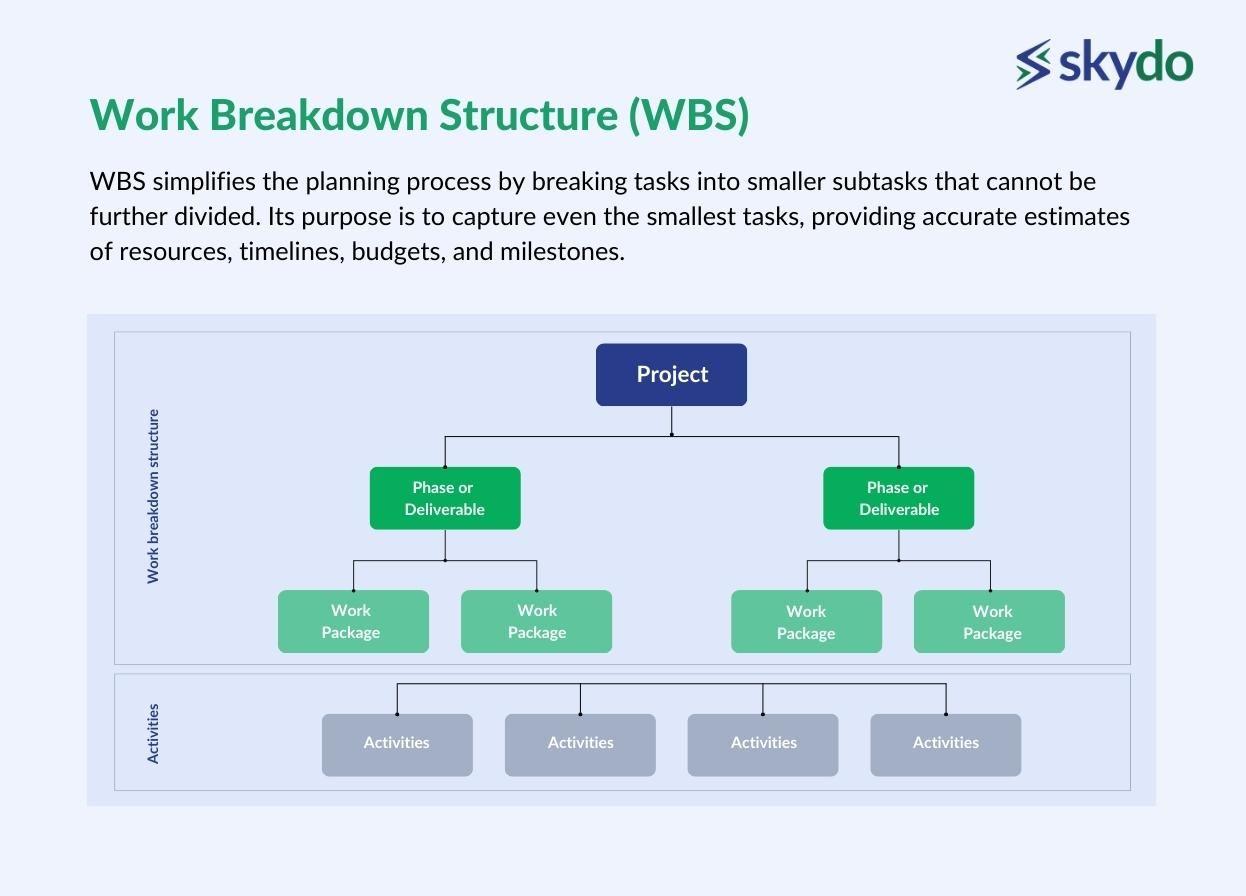
3. Critical Path Method (CPM)
CPM helps with project scheduling by creating a graphical chart with an arrow diagram illustrating the relationship between tasks. It identifies the longest path and determines the shortest timeline to complete tasks effectively.
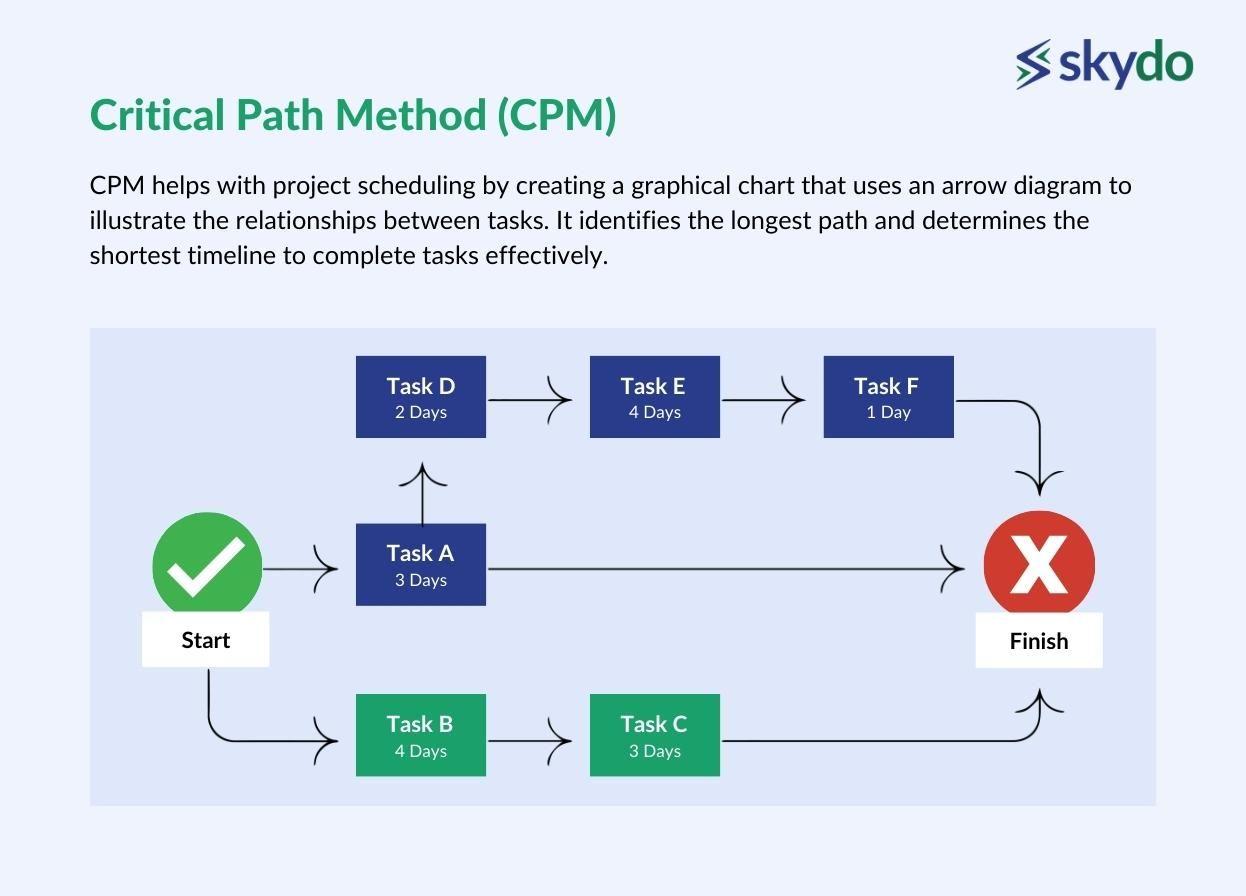
Moreover, you can also use a few project management software like ClickUp, Notion, Asana, Basecamp, Confluence, and Airtable to streamline project planning and management.
From experience, Divyank Jain, Co-founder at The Wise Idiot, explains, “Initially, there was a lot of resistance from our team members about using Basecamp, having tried so many tools before that didn’t seem to suit our needs. We were pen-and-paper people. But over time, as we slowly began using the tool, and realised how it impacted our productivity and processes. Since then, projects have been better streamlined.”
#4. Establish effective communication channels
Team communication and collaboration are the sine qua non for successful project completion. According to PMI’s Pulse of the Profession® survey, poor communication is the second leading cause of project failures.
Project communication has four essential components.
Communication environment
Create a collaborative culture by regularly conducting progress meetings and dedicating specific time for active listening to team members.
Communication channel
Effective communication requires an open and transparent communication culture and mechanism within your team. But how do you establish communication channels?
- Understand your team's behaviour and how they respond to various sources of information.
- Decide the purpose of communication. For example, one-on-one meetings or events are more suitable if you have to communicate complex information.
- Next, consider your communication resources, how you can improve them, and how long it will take to communicate.
Communication cognitive
Address diversity within the team by establishing a standard operating procedure for communication that accommodates the individual preferences of each team member.
Communication system
Create a free system or process for an easy flow of information from the project manager to the team members and vice-versa. Platforms like Slack, Microsoft Teams, Discord and many others are perfect examples of communication systems that businesses use worldwide to facilitate discussions.
#5. Monitor progress and adjust accordingly
As your project picks up speed, it may shift track slightly or even slow down. The change control process helps evaluate progress, analyse changes, assess their impact, and take appropriate actions to adjust for client requirements, market conditions, or resource scarcity.
Here is how you can do it.
- Set up key performance indicators (KPIs) and track them over daily/weekly Scrum meetings. Stakeholders, management, and teams hold meetings to stay aligned with each project step.
- Decide on a limit beforehand which should serve as the benchmark for the allowed changes.
- Analyse your workforce and systems. Identify potential risks initially and adapt to changes and challenges like technological, human, operational, and financial problems.
- Establish clear priorities as per the objectives and goals of the project.
- Focus on crisis management by developing contingency plans, finding the root cause for problems immediately, and communicating the challenges to the stakeholders.
- Adopt a problem-solving or solution-oriented approach instead of focusing on challenges.
#6. Conduct regular reviews and feedback sessions
Continuous improvement is only possible when all team members take accountability for their work or control their actions. But how do you ensure project control?
The simplest solution is a performance review within a few days or after each milestone. The performance review should be a two-way process to allow you and the team members to evaluate the actual deliverables and what was expected. You have to implement a feedback loop with the following main steps:
- Give feedback
- Receive feedback
- Gauge feedback and
- Encourage feedback
However, feedback loops must be short. Adding extra people to the loop complicates the process, leaving everyone frustrated. You can use the RACI matrix to keep it simple:
- R- Responsible
- A - Accountable
- C - Consulted
- I - Informed
You can also try the following tools for performance review and feedback: Reviewsnap, PerformYard, BambooHR, Lattice, and Kissflow HR Cloud.
#7. Celebrate success and learn from failures
Celebrating project success is critical to project management as it helps boost team morale, recognise hard work, and promote learning. You can use a tool for shoutouts. If your team uses Slack, Microsoft Teams, or any other collaborative software, you can create a separate channel to mention all achievements and praise your team members.
The key learnings that you can learn from your unsuccessful projects include:
- Don't view your entire project as a failure. Even though certain aspects fail to work, some of the project elements must have worked out successfully. Look at the silver lining here.
- Evaluate your strengths and weaknesses and set up realistic goals.
- Prepare for your next project and help you identify areas where there is scope for growth and innovation.
Recommended books for further learning
- "The Lean Startup" by Eric Ries
This book explains the meaning of lean startup and the process and techniques for building and growing a startup in uncertain times.
- "Making Things Happen: Mastering Project Management" by Scott Berkun
The author has close to a decade of experience as a project manager. He uses his experience to explain philosophies and strategies for defining and managing software projects.
- "The Deadline," by Tom DeMarco
This book helps you learn how to build and manage an efficient team and focus on interpersonal relationships. If you prefer to read fiction over non-fiction, you must add it to your reading list.
- The "One Minute Manager" by Ken Blanchard and Spencer Johnson
It spills the secrets of effective management and explains three tools: one-minute goals, one-minute praisings, and one-minute reprimands.
The author uses eating the frog as a metaphor for completing the most challenging tasks at the beginning of the day. The book essentially provides techniques on how to manage time efficiently.
FAQs
Q1. What steps are required for the final closure of a project?
Ans: While project delivery is the final step, successful project completion also includes:
- Gathering project records
- Effective review of the project
- Final delivery of project/product to the client and other stakeholders
- Seeking project acceptance from the stakeholders
- Releasing the project team and making final payments
Q2. How to estimate costs for project completion?
Ans: To get a correct cost estimate for your project, start by listing all tasks and resources required to achieve the tasks. Allocate the tasks to various team members and define the turnaround time. Once you gather all the data, you must analyse it to prepare a budget. Like WBS, you can use a Cost Breakdown Structure (CBS) tool to get the costs for even the smallest requirements.
Q3. What should be the documentation process after project completion?
Ans: After you complete the project, make sure to compile all the documents together as soon as possible. This should be done before dissolving the project team or resolving the team members. Gather all the project documents like approvals, reports, plans, contracts, invoices, payment receipts, and research documents and store them safely. You can archive documents on cloud storage as well for easy retrieval.
Q4. What is the first step in project planning?
Ans: The initial step in project planning involves defining the project scope, objectives, and requirements. This sets the foundation for the entire project, outlining what needs to be achieved and the boundaries within which the project will operate.
Q5. Which activity of the project cast a vision of the project?
Ans: Developing a project vision is typically achieved through defining project goals and objectives. This activity provides a clear direction and purpose for the project, guiding all subsequent planning and execution.
Q6. How to create a project plan?
Ans: To create a project plan, follow these steps:
- Define project scope and objectives.
- Identify tasks and activities.
- Sequence tasks and create a timeline.
- Allocate resources.
- Develop a budget.
- Define milestones and deliverables.
- Create a risk management plan.
- Communicate and document the plan for team understanding and alignment.









